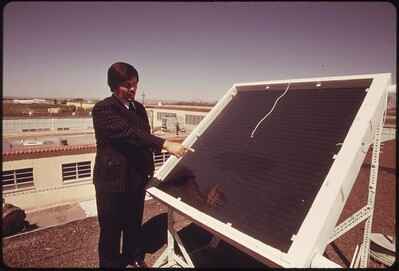5 Advantages of Solar Energy Explained
Advantages of solar energy are; renewable energy resource, no gaseous emissions, multiple uses, low maintenance cost, and remote usage-suitability.
This article discusses the advantages of solar energy, as follows;
1). Renewable Energy Resource (as one of the Advantages of Solar Energy)
One of the most prominent advantages of solar energy lies in the fact that solar radiation is a renewable energy resource.
Solar energy is called renewable because the nuclear fusion reactions occurring in the Sun are spontaneous and continuous, so that solar radiation cannot be exhausted through use.
The solar cell is used to capture and convert this renewable energy resource into electricity through a relatively-simple mechanism called photoelectric conversion; so that it is possible to generate electricity from solar energy as long as radiation is captured.
Being renewable places solar energy at an advantage compared to non-renewable energy resources like fossil fuels, and eliminates the risk of resource depletion associated with energy consumption.
2). No Gaseous Emissions
Solar energy is a zero-emission option, especially during its operational life. This means that in addition to being a renewable energy resource, solar is also a clean energy resource.
Because there are no notable emissions or waste produced while solar is being used for electricity generation, it is not linked to any significant levels of soil, water or air pollution; and neither to global warming or climate change.
Solar energy does not cause pollution during its operational life because it does not need to be extracted from its source through combustion or any break-down process that could release carbon, water vapor or toxins into the environment.
The amount of CO2 emissions saved by solar energy usage in one year, ranges from 268,000 to 304,000 lbs per acre approximately [1].
It is still important to note that the low carbon footprint of solar energy is mostly effective during its operational life; while it is being used to generate electricity. This means that some degree of pollution and gaseous emission is in fact produced over the entire lifecycle of solar energy systems.
The environmental impacts of solar energy development occur during the manufacture and decommissioning or replacement of solar components like panels and batteries.
Solar power produces emissions that range from 30-300g CO2-eq per kWh of electricity, over the entire lifecycle of solar systems [5].
This value, while being an obvious disadvantage for solar energy, is still much lower than the emissions produced by fossil fuels, meaning that solar energy is yet preferable when assessed on the basis of environmental impact. Solar is also clean compared to other renewable energy options like geothermal, bioenergy and wind energy.
3). Multiple Uses (as one of the Advantages of Solar Energy)
One of the advantages of solar energy is its versatility, which can be observed in that solar can be utilized for multiple purposes.
Solar energy can be used in agriculture, manufacturing, transport, and to meet domestic energy needs.
Some uses of solar energy include; space heating, water heating, agricultural greenhouse maintenance, electric vehicle-charging, lighting, and electricity generation.
These multiple uses increase the value and relevance of solar energy development, as well as its potential to play a key role in building a sustainable green economy and achieving energy transition.

4). Low Maintenance Cost
Solar energy systems do not generally need a lot of maintenance, and this can be attributed to the relative simplicity of these systems, and the absence of movable mechanical components like turbines, or combustion components like boilers.
The contrast can be appreciated when we compare solar energy systems with other energy systems like fossil fuel-and-biomass power plants; which require significant levels if maintenance for their several, complex components and intense energy transfer mechanisms.
Solar power plants on the contrary, are usually dominated by solar panels, which are easy and less-demanding to maintain.
Solar panels require very little maintenance because they are fixed, comprise of simple solar cells, and are not involved in intense thermal processes like combustion. These attributes eliminate the maintenance requirements associated with friction, fuel combustion, and multi-component optimization.
The maintenance of a solar power system mostly involves cleaning to remove debris and dirt that could obstruct the efficient capture of solar radiation [3].
Solar panel maintenance costs per year may be around $160 on average, based on a $140-180 range [2]. This is very affordable for many energy users.
Also, with adequate maintenance, a solar power system will last for at least 25 years, which often guarantees a return on investment.
5). Remote Usage Suitability (as one of the Advantages of Solar Energy)
Solar cells and panels are suitable for power supply in remote locations, because of the widespread accessibility of solar energy.
This is a major advantage, because buildings in remote areas often lack access to a regional grid to meet their energy needs.
The relatively-simple structure and set-up of solar systems make them a good fit for rural electrification in remote, developing areas [4].
Panels can be used to generate solar power during hours of peak solar radiation, and some of the power produced can be stored in solar batteries for use during hours with no sunlight.
Aside electrification of individual buildings, small-scale solar power plants can be installed and used with microgrid systems to supply electricity to multiple buildings in remote areas.
The power supplied by solar systems can support various purposes like communication, water supply, lighting, heat and cooling, among others.

Conclusion
Advantages of solar energy are;
1. Renewable Energy Resource
2. No Gaseous Emissions
3. Multiple Uses
4. Low Maintenance Cost
5. Remote Usage Suitability
References
1). Eisenson, M. (2022). "Solar Panels Reduce CO2 Emissions More Per Acre Than Trees — and Much More Than Corn Ethanol." Available at: https://news.climate.columbia.edu/2022/10/26/solar-panels-reduce-co2-emissions-more-per-acre-than-trees-and-much-more-than-corn-ethanol/. (Accessed 28 March 2023).
2). Gerhardt, N. (2022). "The Ultimate Solar Panel Maintenance Guide To Keep Your Panels Working As Efficiently As Possible." Available at: https://www.forbes.com/home-improvement/solar/solar-panel-maintenance-tips/. (Accessed 28 March 2023).
3). Gobler, E. (2021). "Solar panel maintenance guide: How to clean and repair solar panels." Available at: https://www.cnet.com/home/energy-and-utilities/solar-panel-maintenance-guide-how-to-clean-and-repair-solar-panels/. (Accessed 28 March 2023).
4). Osende, B.; Abraham, J. P.; Mowry, G. (2011). "Small-Scale Use of Solar Power in Remote, Developing Regions: A Case Study." Journal of Sustainable Development 4(3). Available at: https://doi.org/10.5539/jsd.v4n3p3. (Accessed 28 March 2023).
5). Reich, N. H.; Alsema, E. A.; Sark, W. V.; Nieuwlaar, E. (2007). "CO2 Emissions of PV in the Perspective of a Renewable Energy Economy." OAI. Available at: https://www.researchgate.net/publication/228769572_CO2_Emissions_of_PV_in_the_Perspective_of_a_Renewable_Energy_Economy. (Accessed 28 March 2023).





